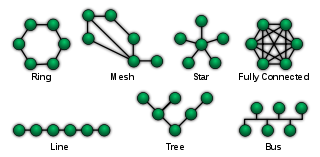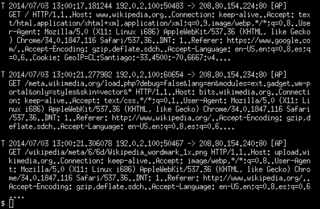A network monitoring interface card or NMIC is similar to a network card (NIC). However, unlike a standard network card, an NMIC is designed to passively (and silently) listen on a network. At a functional level, an NMIC may differ from a NIC, in that the NMIC may not have a MAC address, may lack the ability to transmit and may not announce its presence on a network. Advanced NMICs have features that include an ability to offload CPU intensive processing from a system's CPU, accurate time measurement, traffic filtering, and an ability to perform other application specific processing.
Organizations often use a dedicated interface for all management traffic and thus create a management network. This is done to minimize the impact on production traffic, ensure the integrity of management traffic and it helps by measuring true production traffic not the traffic generated to the act of measuring traffic. This is a separate function from NMICs that are used for data collection and processing.
NMICs are typically used in intrusion detection and prevention (IDS/IPS), lawful interception, flow analysis, network monitoring, and protocol analyzer systems.
Notable manufacturers include Endace, SolarFLare and Intel.

A packet analyzer, also known as packet sniffer, protocol analyzer, or network analyzer, is a computer program or computer hardware such as a packet capture appliance, that can intercept and log traffic that passes over a computer network or part of a network. Packet capture is the process of intercepting and logging traffic. As data streams flow across the network, the analyzer captures each packet and, if needed, decodes the packet's raw data, showing the values of various fields in the packet, and analyzes its content according to the appropriate RFC or other specifications.

An intrusion detection system is a device or software application that monitors a network or systems for malicious activity or policy violations. Any intrusion activity or violation is typically reported either to an administrator or collected centrally using a security information and event management (SIEM) system. A SIEM system combines outputs from multiple sources and uses alarm filtering techniques to distinguish malicious activity from false alarms.

A network interface controller is a computer hardware component that connects a computer to a computer network.

A spectrum analyzer measures the magnitude of an input signal versus frequency within the full frequency range of the instrument. The primary use is to measure the power of the spectrum of known and unknown signals. The input signal that most common spectrum analyzers measure is electrical; however, spectral compositions of other signals, such as acoustic pressure waves and optical light waves, can be considered through the use of an appropriate transducer. Spectrum analyzers for other types of signals also exist, such as optical spectrum analyzers which use direct optical techniques such as a monochromator to make measurements.
Deep packet inspection (DPI) is a type of data processing that inspects in detail the data being sent over a computer network, and may take actions such as alerting, blocking, re-routing, or logging it accordingly. Deep packet inspection is often used to baseline application behavior, analyze network usage, troubleshoot network performance, ensure that data is in the correct format, check for malicious code, eavesdropping, and internet censorship, among other purposes. There are multiple headers for IP packets; network equipment only needs to use the first of these for normal operation, but use of the second header is normally considered to be shallow packet inspection despite this definition.

Network security consists of the policies, processes and practices adopted to prevent, detect and monitor unauthorized access, misuse, modification, or denial of a computer network and network-accessible resources. Network security involves the authorization of access to data in a network, which is controlled by the network administrator. Users choose or are assigned an ID and password or other authenticating information that allows them access to information and programs within their authority. Network security covers a variety of computer networks, both public and private, that are used in everyday jobs: conducting transactions and communications among businesses, government agencies and individuals. Networks can be private, such as within a company, and others which might be open to public access. Network security is involved in organizations, enterprises, and other types of institutions. It does as its title explains: it secures the network, as well as protecting and overseeing operations being done. The most common and simple way of protecting a network resource is by assigning it a unique name and a corresponding password.
TCP offload engine (TOE) is a technology used in some network interface cards (NIC) to offload processing of the entire TCP/IP stack to the network controller. It is primarily used with high-speed network interfaces, such as gigabit Ethernet and 10 Gigabit Ethernet, where processing overhead of the network stack becomes significant. TOEs are often used as a way to reduce the overhead associated with Internet Protocol (IP) storage protocols such as iSCSI and Network File System (NFS).

NetFlow is a feature that was introduced on Cisco routers around 1996 that provides the ability to collect IP network traffic as it enters or exits an interface. By analyzing the data provided by NetFlow, a network administrator can determine things such as the source and destination of traffic, class of service, and the causes of congestion. A typical flow monitoring setup consists of three main components:

A network processor is an integrated circuit which has a feature set specifically targeted at the networking application domain.
Network monitoring is the use of a system that constantly monitors a computer network for slow or failing components and that notifies the network administrator in case of outages or other trouble. Network monitoring is part of network management.
In the field of computer network administration, pcap is an application programming interface (API) for capturing network traffic. While the name is an abbreviation of packet capture, that is not the API's proper name. Unix-like systems implement pcap in the libpcap library; for Windows, there is a port of libpcap named WinPcap that is no longer supported or developed, and a port named Npcap for Windows 7 and later that is still supported.
Layered Service Provider (LSP) is a deprecated feature of the Microsoft Windows Winsock 2 Service Provider Interface (SPI). A Layered Service Provider is a DLL that uses Winsock APIs to attempt to insert itself into the TCP/IP protocol stack. Once in the stack, a Layered Service Provider can intercept and modify inbound and outbound Internet traffic. It allows processing of all the TCP/IP traffic taking place between the Internet and the applications that are accessing the Internet. For example, it could be used by malware to redirect web browers to rogue websites, or to block access to sites like Windows Update. Alternatively, a computer security program could scan network traffic for viruses or other threats. The Winsock Service Provider Interface (SPI) API provides a mechanism for layering providers on top of each other. Winsock LSPs are available for a range of useful purposes, including parental controls and Web content filtering. The parental controls web filter in Windows Vista is an LSP. The layering order of all providers is kept in the Winsock Catalog.
Zeek is a free and open-source software network analysis framework; it was first developed in 1994 by Vern Paxson and was originally named in reference to George Orwell's Big Brother from his novel Nineteen Eighty-Four. It is designed to be a network security monitor (NSM) but can also be used as a network intrusion detection system (NIDS) coupled with additional live analysis of network events. It is released under the BSD license.

OSSIM is an open source security information and event management system, integrating a selection of tools designed to aid network administrators in computer security, intrusion detection and prevention.
Intrusion detection system evasion techniques are modifications made to attacks in order to prevent detection by an intrusion detection system (IDS). Almost all published evasion techniques modify network attacks. The 1998 paper Insertion, Evasion, and Denial of Service: Eluding Network Intrusion Detection popularized IDS evasion, and discussed both evasion techniques and areas where the correct interpretation was ambiguous depending on the targeted computer system. The 'fragroute' and 'fragrouter' programs implement evasion techniques discussed in the paper. Many web vulnerability scanners, such as 'Nikto', 'whisker' and 'Sandcat', also incorporate IDS evasion techniques.
In computing, Microsoft's Windows Vista and Windows Server 2008 introduced in 2007/2008 a new networking stack named Next Generation TCP/IP stack, to improve on the previous stack in several ways. The stack includes native implementation of IPv6, as well as a complete overhaul of IPv4. The new TCP/IP stack uses a new method to store configuration settings that enables more dynamic control and does not require a computer restart after a change in settings. The new stack, implemented as a dual-stack model, depends on a strong host-model and features an infrastructure to enable more modular components that one can dynamically insert and remove.
Telesoft Technologies is a privately held UK based technology company which develops cyber security, telecoms mobile products and services and government infrastructure. Telesoft has operations in USA, UK and India.

Network forensics is a sub-branch of digital forensics relating to the monitoring and analysis of computer network traffic for the purposes of information gathering, legal evidence, or intrusion detection. Unlike other areas of digital forensics, network investigations deal with volatile and dynamic information. Network traffic is transmitted and then lost, so network forensics is often a pro-active investigation.

ngrep is a network packet analyzer written by Jordan Ritter. It has a command-line interface, and relies upon the pcap library and the GNU regex library.
Data center security is the set of policies, precautions and practices adopted at a data center to avoid unauthorized access and manipulation of its resources. The data center houses the enterprise applications and data, hence why providing a proper security system is critical. Denial of service (DoS), theft of confidential information, data alteration, and data loss are some of the common security problems afflicting data center environments.








